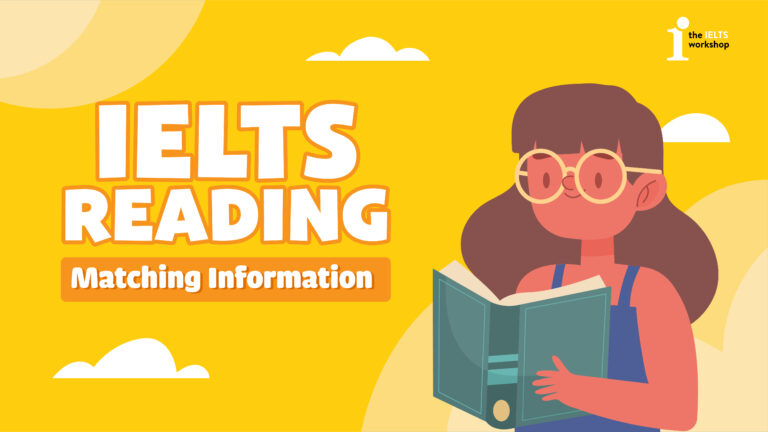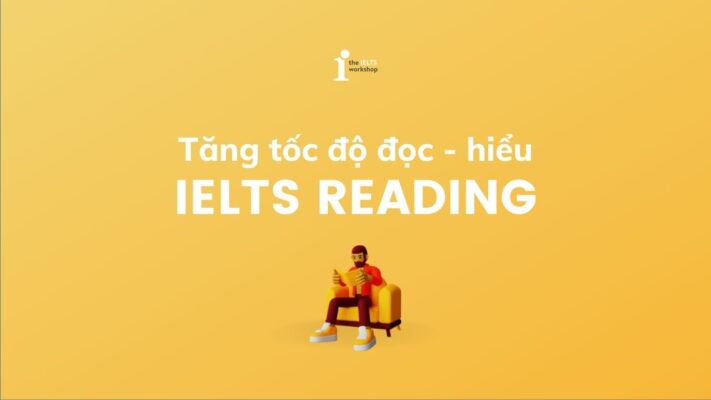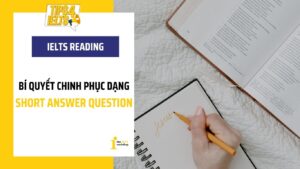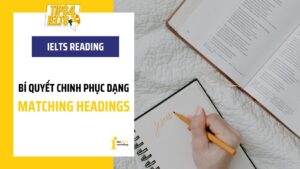Matching Information là một trong những dạng bài phổ biến của phần thi IELTS Reading. Hãy cùng The IELTS Workshop (TIW) tìm hiểu cách làm dạng bài Matching Information IELTS Reading sao cho nhanh chóng, hiệu quả và dễ dàng ghi điểm nhé.
1. Dạng bài Matching Information là gì?
1.1. Format bài Matching Information
Matching Information là dạng bài nối thông tin cho trước với đoạn văn trong bài đọc chứa thông tin đó.
Cụ thể là thông qua bài đọc cho trước, người đọc cần nối các statements (các câu thông tin) tương thích với các đoạn văn có chứa thông tin phù hợp. Các đoạn văn sẽ được đánh dấu theo thứ tự bảng chữ cái A, B, C, D,… để thí sinh điền đáp án. Còn các câu hỏi sẽ xoay quanh về các thông tin khác nhau như lý do, miêu tả, định nghĩa, tóm tắt,…

1.2. Những lưu ý đối với dạng bài Matching Information
Để có thể làm tốt dạng bài Matching Information IELTS Reading, bạn cần lưu ý những điều dưới đây:
- Số đoạn văn sẽ thường nhiều hơn số câu hỏi.
- Những keyword được sử dụng trong câu hỏi thường sẽ khác với các từ trong đoạn văn (sử dụng những từ/cụm từ đồng nghĩa).
- Có đoạn văn không chứa thông tin trả lời cho bất kỳ câu hỏi nào. Có đoạn văn lại chứa nhiều đáp án.
- Các đáp án cho câu hỏi sẽ không trải đều từ trên xuống dưới. Ví dụ như, bạn tìm ra đáp án câu 2 ở đoạn B, thì không đồng nghĩa đáp án câu 3 sẽ ở đoạn C. Nó có thể ở đoạn A hoặc phía trước câu 2 nhưng cùng đoạn B.
- Thông tin cần nắm chưa chắc là ý chính, nó có thể là ý phụ hoặc thông tin bên lề. Thí sinh phải đọc đi đọc lại đoạn văn nhiều lần mới tìm ra được câu trả lời thích hợp.
- Đối với dạng bài Matching Information, bạn nên làm sau cùng khi đã hoàn thành các dạng bài khác. Khi đó bạn nắm được tương đối nội dung của bài, xác định được thông tin cần nằm ở đoạn nào và cũng giúp bạn đẩy nhanh thời gian hoàn thành bài hơn.
1.3. Khó khăn gặp phải khi luyện đề Matching Information
- Vấn đề lớn đối với các sĩ tử khi làm Matching Information là phải đọc hiểu ý nghĩa của từng đoạn văn riêng lẻ trong thời gian ngắn. Thông tin cần nắm có thể nằm bất cứ đâu và rải rác khắp nơi thay vì tập trung vào câu đầu hay câu cuối của đoạn như các dạng bài khác. Chính vì vậy, dù bạn đã hoàn thành những câu hỏi khác ở phía trước, bạn vẫn sẽ mất nhiều thời gian tìm thông tin cho những câu hỏi còn lại.
- Đáp án không chỉ nằm trong 1 – 2 câu văn của đoạn mà đôi khi là ý chính của cả đoạn, nên bạn cần đọc hết và tóm tắt. Bạn phải đọc kỹ từng chi tiết, từ ý chính đến ý phụ và cần nhiều thời gian để thực hiện. Bên cạnh đó cũng có rất nhiều thông tin gây “nhiễu” khi làm bài.
- Dạng bài này sẽ khó hơn Matching Headings. Với Matching Headings, bạn chỉ cần đọc lướt và nắm ý chính là tìm được đáp án. Với Matching Information, bạn cần tìm câu trả lời từ toàn bộ thông tin hay từ những chi tiết nhỏ.
2. Cách làm dạng bài Matching Information

Dưới đây là chiến thuật làm bài Matching Information trong IELTS Reading. Hãy nhớ rằng có rất nhiều cách làm bài khác nhau nên các bạn hãy lựa chọn ra cách làm nào phù hợp với mình nhất. Bạn cũng có thể áp dụng chiến thuật này sao cho phù hợp với phong cách của bản thân nhé.
Bước 1: Đọc kỹ đề
Bước quan trọng đầu tiên bạn cầm làm là xác định yêu cầu của đề bài. Ngoài ra, bạn hãy chú ý xem đề bài có cho phép thí sinh được chọn một đoạn văn để trả lời cho nhiều câu hỏi không bằng việc xem có câu “NB: You may use any letter more than once” trong đề hay không.
Bước 2: Nắm ý chính trong câu hỏi & highlight keywords
Các câu hỏi trong Matching Information rất khó do các thông tin nằm rải rác khắp nơi trong bài đọc. Câu trả lời có thể đến từ các chi tiết nhỏ nhất trong bài đọc mà các bạn dễ bỏ qua. Sau khi đã nắm khái quát ý chính của câu hỏi từ keyword, việc tìm thông tin từ các đoạn liên quan là cách dễ dàng nhất để chọn được đáp án nhanh chóng.
Bước 3: Đọc toàn bộ nội dung của bài
Sau khi đã xác định được ý chính của câu hỏi, đọc lướt nhanh qua nội dung của toàn bộ bài đọc. Phương pháp skim & scan nên được tận dụng triệt để ở bước này. Trong quá trình đọc, cần nắm được ý chính của từng đoạn. Để ý các keyword trong câu hỏi có thể xuất hiện nguyên văn hoặc sử dụng cụm từ thay thế khác trong đoạn văn. Nếu có thông tin trả lời cho câu hỏi thì khoanh vùng trong bài đọc.
Bước 4: Đọc lại lần lượt từng câu hỏi và đoạn văn có chứa thông tin liên quan.
Sau khi đã khái quát được cả nội dung câu hỏi và các đoạn văn, các bạn sẽ tìm ra được câu trả lời thích hợp từ các thông tin được đánh dấu. Với mỗi câu hỏi, hãy đọc kỹ lại (scan) đoạn văn tiềm năng mà bạn đã khoanh vùng ở Bước 3.
- Tìm kiếm sự liên kết về ý nghĩa: Đừng chỉ “săn” keywords một cách máy móc. Hãy tìm những từ đồng nghĩa (synonyms) hoặc cách diễn đạt lại (paraphrasing) của keywords trong câu hỏi.
- Đối chiếu thông tin: Khi tìm thấy một câu hoặc cụm từ có vẻ liên quan, hãy đọc kỹ lại câu hỏi một lần nữa để chắc chắn rằng thông tin này trả lời đúng cho câu hỏi đó.
- Loại trừ: Nếu bạn phân vân, hãy tạm thời để đó và làm các câu dễ hơn trước. Quay lại sau và sử dụng phương pháp loại trừ.
Bước 5: Kiểm tra.
Sau khi đã điền hết đáp án, hãy dành 1-2 phút cuối để rà soát lại:
- Đảm bảo bạn đã viết đúng ký tự của đoạn văn (A, B, C…) vào phiếu trả lời.
- Kiểm tra xem tất cả các câu hỏi đã được trả lời chưa.
- Nếu có dạng “You may use any letter more than once”, hãy xem lại những đoạn văn đã được chọn nhiều lần xem có hợp lý không, và những câu hỏi khó có thể có cùng đáp án với một câu dễ hơn không.
Xem thêm Các dạng và cách làm bài IELTS Reading chi tiết:
- Hướng dẫn cách làm dạng bài Matching Features IELTS Reading
- Hướng dẫn cách làm dạng bài Matching Information
- Hướng dẫn cách làm dạng bài Matching Sentence Endings
- Các lỗi thường gặp ở dạng bài IELTS Reading Multiple Choice
3. Ví dụ cho dạng bài Matching Information
3.1. Đề bài
Uses of Leisure time
A. Although it may seem that people are working more, studies show that we have more leisure time than ever before. Yet researchers are reporting higher levels of both stress and obesity. These reports appear to be a sign that we are not using our leisure time to our best advantage.
B. Health experts agree that the best way to restore body and mind is to spend time in nature pursuing a comfortable level of physical exercise. Spending time in natural surroundings is especially crucial now because, for the first time, a majority of the world’s population live in cities. Recent studies show that intellectual function weakens as a result of the energy expended simply sorting out the overwhelming stimuli of city life. Tests demonstrate that people suffer decreases in attention in span, memory, and problem-solving ability after taking a short walk on a busy street or merely seeing pictures of city life. Tests also show that time spent in the city results in a decreased ability to concentrate and to control emotions and impulses. On the other hand, spending time in the country produces the opposite effects.
C. Unfortunately, as society becomes more centered on city life, we have to rejuvenate ourselves in nature deliberately rather than as a matter of course. Yet research shows that we are not spending our leisure time rejuvenating ourselves. . Around the world, the most popular way to spend free time is watching television. This, the most passive of pastimes, is how Americans spend more than half their leisure time. Globally, the next most popular is using the Internet, also passive, and it ranks as the most favored among the billions in China. The third is shopping, which may be slightly more active but is still as far from nature as possible. Modern shopping malls remove shoppers from everything natural, leaving them to experience the outdoors only between the paved parking lot and the mall doors.
D. Children are most negatively affected by city life. Parents are reluctant to let children play freely in the city, fearing for their health and safety,and nature is something many children in the city may never have a chance to experience. Childhood obesity and depression are reachingepidemic levels. Authorities have begun to acknowledge the problem,and innovative programs that give children an opportunity to spend time in nature are being introduced in countries around the world.
E. Vacations are the most obvious chunk of leisure time. The countries with the most vacation time are Italy, with an average of forty-two days a year, and France, with thirty-seven. The industrious Americans have the least: thirteen days. Yet people in the country most satisfied with their vacations are not the Italians but the British. The British usually divide up their vacation time, taking it in pieces throughout the year rather than all at once. Of all nationalities, the British spend the most vacationing outdoors in their national-trust parks, where they engage in a comfortable level of physical activity. The British report the greatest satisfaction with their leisure time. Perhaps the rest of the world would do well to follow their lead.

3.2. Hướng dẫn và gợi ý làm bài
1. Gạch chân các keyword: most popular/ pastimes/ around the world
Đọc lướt ở đoạn C – dòng 4: “around the world, the most popular way to spend free time is watching TV… globally, the next most popular is using the Internet”
→ Đáp án C
2. Gạch chân các keyword: why/ crucial/ in nature
Đọc lướt đến đoạn B – dòng 1: “the best way to restore body and mind is to spend time in nature…spending time in natural surroundings is especially crucial now because…”
→ Đáp án B
3. Gạch chân các keyword: which country/ largest chunk of vacation time/ outdoor activities
Đọc lướt đến đoạn E – dòng 7 sẽ thấy các keyword: Of all nationalities, the British spend the most time vacationing outdoors
→ Đáp án E
4. Bài tập về Matching Information
The Conquest of Malaria in Italy, 1900-1962
Malaria. Bad air. Even the word is Italian, and this horrible disease marked the life ofthose in the peninsula for thousands of years. Yet by 1962, Italy was officially declared malaria-free, and it has remained so ever since. FrankSnowden’s study of this success story takes us to areas historians have rarelyvisited before.
A. Everybody now knows that malaria is carried by mosquitoes. But in the 19thcentury, most experts believed that the disease was produced by ”miasma” or ”poisoning of the air”. Others made a linkbetween swamps, water and malaria, but did not make the further leap towardsinsects. The consequences of these theories were that little was done to combatthe disease before the end of the century. Things became so bad that 11m Italians (from a total population of 25m) were ”permanently at risk”. Inmalarial zones the life expectancy of land workers was a terrifying 22.5 years.Those who escaped death were weakened or suffered from splenomegaly — a”painful enlargement of the spleen” and ”a lifeless stare”.The economic impact of the disease was immense. Epidemics were blamed onsouthern Italians, given the widespread belief that malaria was hereditary. Inthe 1880s, such theories began to collapse as the dreaded mosquito was identifiedas the real culprit.
B. Italian scientists, drawing on the pioneering work of French doctor AlphonseLaveran, were able to predict the cycles of fever but it was in Rome that further key discoveries were made. Giovanni Battista Grassi, a naturalist,found that a particular type of mosquito was the carrier of malaria. By experimenting on healthy volunteers (mosquitoes were released into rooms wherethey drank the blood of the human guinea pigs), Grassi was able to make the direct link between the insects (all females of a certain kind) and thedisease. Soon, doctors and scientists made another startling discovery: the mosquitoes themselves were also infected and not mere carriers. Every year,during the mosquito season, malarial blood was moved around the population by the insects. Definitive proof of these new theories was obtained after anextraordinary series of experiments in Italy, where healthy people wereintroduced into malarial zones but kept free of mosquito bites — and remainedwell. The new Italian state had the necessary information to tackle thedisease.
C. A complicated approach was adopted, which made use of quinine – a drug obtainedfrom tree bark which had long been used to combat fever, but was now seen as acrucial part of the war on malaria. Italy introduced a quinine law and aquinine tax in 1904, and the drug was adminis tered to large numbers of rural workers. Despite its often terrible side-effects (the headaches produced wereknown as the ”quinine-buzz”) the drug was successful in limiting thespread of the disease, and in breaking cycles of infection. In addition, Italyset up rural health centres andinvestedheavily in education programmes. Malariaas Snowden shows, was not just a medical problem, but a socia and regional issue,and could only be defeated through multi-layered strategies. Politics was itself transformed by the anti-malarial campaigns. It was originally decided togive quinine to all those in certain regions even healthy people; peasants were often suspicious of medicine being forced upon them. Doctors weie sometimes metwith hospitality andrefusal, and many were dubbed ”poisoners”.
D. Despite these problems, the strategy was hugely successful. Deaths from malaria fell bysome 80% in the first decade of the 20th century and some areas escaped altogether from the scourge of the disease. War. from 1915-18, delayed thecampaign. Funds were diverted to the battlefields and the fight against malaria became a military issue, laying the way for the fascist approach to theproblem. Mussolini’s policies in the 20s and 30s are subjected to a serious cross-examination by Snowden. He shows how much of the regime’s claims to have ”eradicated” malaria through massive land reclamation, forced population removals and authoritarian clean-ups were pure propaganda. Massdraining was instituted often at a great cost as Mussolini waged war not on the disease itself, but on the mosquitoes that carried it. The cleansing of Italywas also ethnic, as ”carefully selected” Italians were chosen toinhabit the gleaming new towns of the former marshlands around Rome. The ”successes under fascism were extremely vulnerable, based as they were ona top-down concept of eradication. As war swept through the drained lands inthe 40s, the disease returned with a vengeance.
E. In the most shocking part of the book, Snowden describes — passionately, but withthe skill of a great historian — how the retreating Nazi armies in Italy in1943-44 deliberately caused a massive malaria epidemic in Lazio. It was ”the only known example of biological warfare in 20th-centuryEurope”. Shamefully, the Italian malaria expert Alberto Missiroli had arole to play in the disaster: he did not distribute quinine, despite being wellaware of the epidemic to come. Snowden claims that Missiroli was alreadypreparing a new strategy — with the support of the US Rockefeller Foundation —using a new pesticide, DDT. Missiroli allowed the epidemic to spread, in orderto create the ideal conditions for a massive, and lucrative, human experiment.Fifty-five thousand cases of malaria were recorded in the province of Littoriaalone in 1944. It is estimated that more than a third of those in the affectedarea contracted the disease. Thousands, nobody knows how many, died. With thewar over, the US government and the Rockefeller Foundation were free toexperiment. DDT was sprayed from the air and 3m Italians had their bodiescovered with the chemical. The effects were dramatic, and nobody really caredabout the toxic effects of the chemical.
F. By 1962, malaria was more or less gone from the whole peninsula. The last caseswere noted in a poor region of Sicily. One of the final victims to die of the disease in Italy was the popular cyclist, Fausto Coppi. He had contractedmalaria in Africa in 1960, and the failure of doctors in the north of Italy tospot the disease was a sign of the times. A few decades earlier, they wouldhave immediately noticed the tell-tale signs; it was later claimed that a smalldose of quinine would have saved his life. As there are still more than 1mdeaths every year from malaria worldwide, Snowden’s book also has contemporary relevance. This is a disease that affects every level of the societies where itis rampant. It also provides us with “a message of hope for a world-struggling with the great present-day medical emergency”.
Question 1-5
Reading Passage has six paragraphs, A-F
Which paragraph contains the following information
Write the correct letter, A – F, in boxes 1-5 on your answer sheet.
1. A breakthrough in the theory of the cause of malaria.
2. A story for today’s readers.
3. A description of an expert who didn’t do anything to restrict the spread of disease.
4. A setback in the battle against malaria due to government policies.
5. A description of how malaria affects the human body.
Đáp án
1 – B
2 – F
3 – E
4 – D
5 – E
Trên đây là một số chiến thuật cho dạng bài Matching Information đặc biệt hữu hiệu cho những ai đang ôn luyện Reading. Chúc các bạn sớm chinh phục được dạng bài tập này.
Tham khảo khóa học Junior tại The IELTS Workshop để biết phương pháp ôn luyện toàn diện cho kỹ năng Reading nói riêng và IELTS nói chung.









